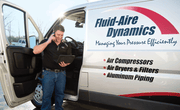Industrial compressed air system design is essential to reduce energy consumption, ensure safety, and improve the reliability and longevity of your equipment. Properly designed and maintained compressed air systems can achieve energy savings of 20-50% and overall reductions in operations costs of 10-30%. Good design starts with understanding your compressed air demand, air quality requirements, facility constraints and business goals. Read on to learn how to right-size your air compressor, optimize air treatment, and reduce energy and operating costs related to compressed air production.
Compressed Air System Design Considerations
There are a number of important considerations in industrial compressed air system design, including energy efficiency, piping system layout, compressed air quality and maintenance costs. This compressed air system design guide can help you make the right decisions.
Business Demand for Compressed Air

The first question to ask when designing compressed air systems is: how much air do you need? Air compressor sizing comes down to two important considerations: airflow (in cubic feet per minute, or CFM) and pressure (in pounds per square inch, or PSI). A compressor of a given horsepower (HP) is rated for a maximum CFM at a certain pressure (for example, 100 CFM at 100 PSI).
To calculate your CFM requirements, add up how much CFM each of the machines or tools in your facility requires. You will need to know the operating pressure requirements and the duty cycles for each piece of equipment that will be attached to the compressor. The compressor should be sized to meet the peak CFM demand in your facility. You can also calculate compressed air usage for an existing facility using a pump-up test or flow meter. See our handy CFM calculator to learn more.
Keep in mind that some pressure will be lost to leaks and friction in the compressed air distribution system. Make sure your system has enough CFM capacity to overcome leakage and pressure drop and ensure adequate PSI at the ends of each line. You can minimize your CFM requirements by repairing compressed air leaks in your system.

Aire Tip: Many plants are operating at higher pressures than required for their equipment. Lowering the PSI of your plant to just above minimum operating pressures can save energy and money.
Required Compressed Air Quality
The second question to consider for compressed air system design is compressed air quality. How clean and dry does your air need to be? Air used for general manufacturing applications may not have very stringent quality requirements (though excess moisture in compressed air is almost always a problem). On the other hand, if you are using air for pharmaceutical or food production or medical applications, your air may be required to meet strict quality standards. The ISO 8573-1 air quality standard grades compressed air purity on three metrics:
- Dry particulate [A]
- Total moisture content [B]
- Oil carryover [C]
ISO 8573 classifies are on a 0-10 (X) scale, with 0 being the highest purity and 10 (X) the lowest purity. Each element is rated separately in an [A] [B] [C] format.

| Level 1 | Level 2 | Level 3 |
|---|---|---|
|
|
|
| ISO 8573-1 Classes 5-6 | ISO 8573-1 Classes 3-4 | ISO 8573-1 Classes 0-2 |
General guidelines only. Consult industry guidelines and regulations for your exact processes.
Once you understand your compressed air purity requirements, you can design the system to meet those standards. Typically, this involves two important elements in compressed air system design.
- Air Dryers: Air dryers remove excess moisture from compressed air. There are two types of compressed air dryers: refrigerated vs. desiccant dryers. Refrigerated dryers work by chilling air and allowing moisture to drop out naturally as it cools. These dryers can lower the dew point of compressed air to ~38°F, which is sufficient for most applications. Applications requiring ultra-dry air (ISO classes 1, 2 & 3), such as pharma or medical, may need a desiccant air dryer. These use a desiccant material (such as activated alumina or molecular sieve desiccants) to actively remove moisture from the air via adsorption. Desiccant air dryers can get air down to a dew point of -40°F to -100°F.
- Filtration: Your second line of defense for compressed air quality is inline filtration. Inline filters remove any remaining moisture as well as oil carryover and dry particulate. They may be installed before or after the air dryers or immediately before the point of use. Standard particulate filters remove solid particulate such as pollen and dust from intake air or contaminants from the air compressor. A coalescing filter will remove oil droplets along with dry particulate and is recommended when dealing with oil mists. Activated carbon may be needed to remove odors, vapors and gases.
Aire Tip: Some specialty applications may require an oil-free air compressor, but the right combination of inline filtration and drying equipment can meet almost all air purity requirements — even for food and pharma. Ask us how!
Compressed Air Distribution System

The design of the compressed air distribution system is critical to the overall efficiency and effectiveness of the compressed air system. A poorly designed distribution system will result in excess pressure drop (loss of PSI) at the end of the air lines, requiring plants to raise overall plant pressure to compensate. This is highly inefficient and drives up operational costs considerably.
Efficient compressed air distribution system design will vastly improve the overall performance of your system. Typically, this means a loop-style distribution system, which allows air to flow in any direction and find the path of least resistance. It is also important to have proper compressed air pipe sizing, both in the main distribution loop and in the connections between the compressor and the loop and the loop and the endpoints. To minimize pressure drop, limit the number of elbows and tees and avoid the use of hoses and quick couplings. Also, consider compressed air piping material; a high-quality aluminum piping system will last longer and minimize air leaks, reducing the total lifecycle cost of the system.
Aire Tip: Piping between the air dryer or dry storage tank and distribution loop should be at least one size larger than the piping in the distribution loop itself. Our compressed air pipe sizing chart can help you size piping appropriately.
Compressed Air Energy Efficiency

Energy efficiency is an important consideration in compressed air system design. It takes about 7 - 8 HP of electricity to make 1 HP of compressed air, so improving energy efficiency can make a big difference in your operating costs. How do you reduce energy use for compressed air? As explained above, reducing overall plant pressure to the minimum PSI requirement and designing an efficient compressed air distribution system will go a long way toward improving energy efficiency. There are several other important energy considerations.
- Reduce Air Loss: Fixing leaks is one of the most important things you can do to increase the overall efficiency of your compressed air system — and in many cases, you can even get leaks fixed for free through incentives from your energy provider! Leak repair can save hundreds or thousands on your annual energy bill. In addition, look for other places where air is lost, such as quick couplings, manual condensate drains, or inappropriate uses of compressed air.
- Minimize Pressure Drop: Pressure drop refers to the loss of PSI between the compressor and the point of use, and it’s another driver for high energy bills. Pressure drop may be caused by an inadequate or poorly designed distribution system, loaded inline filters, undersized air dryers, and leaks or blockages in the system. Diagnosing and solving common causes of pressure drop will increase the efficiency of your system.
- Consider a VSD Air Compressor: If your compressed air usage varies from moment to moment, shift to shift, or season to season, you may benefit from a variable speed drive (VSD) air compressor. A VSD compressor lowers energy costs by ramping the motor speed up or down in response to actual air demand. That way, you’re not paying for more air production than you need. A VSD compressor can also help keep plant pressure more consistent.
Aire Tip: If you are considering energy-saving upgrades to your compressed air system, your energy provider may help to pay the bill. Check out energy incentives in your area.
Compressed Air Storage
How much compressed air storage do you need for your system? An air receiver tank can help you even out compressed air demand and power short, high-demand events without increasing the CFM for your whole system. This may allow you to get by with a smaller HP compressor. The compressed air tank also allows air to cool down and excess moisture to drop out of the air, increasing the effectiveness of the air dryers and heat exchangers. There are a few considerations when deciding how much air storage capacity you need.
- Is your air usage steady, or do your applications use air in short, quick bursts? Facilities with high variability and short demand peaks will benefit from having more storage. As a rule of thumb, plan for about three to five gallons of air storage capacity per compressor CFM output.
- Do you need wet storage or dry storage? Air tanks may be placed either before or after the air dryers. Wet storage (before the air dryers) cools air down and removes some moisture before air goes to the dryers, allowing you to get by with a smaller drying system. Dry storage, on the other hand, is available for immediate use, so it is best if you are relying on stored air to meet sudden demand peaks. A ratio of about 1/3 wet to 2/3 dry storage capacity works well for many applications.
Aire Tip: Make sure your compressed air storage tank is ASME certified and is inspected on a regular basis to stay in code.
Compressed Air System Installation

Compressed air system installation will impact the overall performance of the system. Whether you are installing a new system, replacing or upgrading your air compressor, or adding onto an existing system, it is important to work with an engineering partner who understands compressed air system design and will ensure that everything is installed for maximum efficiency and performance. For example, we see many cases where distribution systems are expanded and new drops are put in without consideration for what this will do to pressure drop and the overall efficiency of the system. In other cases, the compressor may not be installed correctly or located in an appropriate place.
Compressor location and compressor room configuration are important considerations for installation. Will the compressor be inside or outside? If outside, does the system need to be insulated or winterized to protect it from the elements? If inside, does the compressor have enough space around it, and is the compressor room adequately ventilated to prevent air compressor overheating? Installers must consider the optimal temperature range for compressed air equipment when making these decisions. Compressor location will also impact the length of the piping runs required for distribution; longer runs result in more friction, higher pressure drop, and more opportunities for leakage. Noise may be another consideration in determining the best location for the compressor.
Aire Tip: Keep ventilated air flowing over the compressor at all times to prevent overheating and reduce strain on the air compressor cooling system.
Compressed Air System Maintenance

Don’t forget compressed air system maintenance requirements when designing your compressed air system. The compressor should be located in an area that is easy to get to and can be accessed for proper maintenance or compressor repair. Regular inspection and preventative maintenance are required to keep your system running at optimal efficiency and prevent expensive unplanned downtime and emergency repairs. If you have the capacity and expertise on your in-house maintenance team, you may be able to perform these activities yourself. However, for an industrial air compressor, such as a rotary screw compressor, it often makes sense to contract with an expert for PM and repair services. Air dryers and other peripheral equipment also require regular PM. And don’t forget the distribution system; check for leaks annually and have them repaired when they are found.
Aire Tip: Follow manufacturer recommendations for PM for your make and model of air compressor and air dryer based on your usage patterns to keep your system in top operating condition.
Frequently Asked Questions (FAQ)
What Are the Key Factors to Consider When Designing a Compressed Air System?
- Air Demand: How much air is needed for your processes? What is the peak demand for all processes used simultaneously? How variable is your demand over each shift, week or season?
- Air Quality: How clean does air need to be for your processes? How sensitive are your processes to particulate, oil or moisture contamination? Are their industry standards or regulations dictating air quality requirements?
- Facility Constraints: What is the available space for the air compressor and associated equipment? Are there any height restrictions or physical obstacles that could impact installation? How far is the distance from the compressor to the point of use, and how will this affect pressure drops?
- Utility Access: What are the electrical requirements for the compressors? Is there sufficient power supply and backup systems in place? What are the plumbing and drainage requirements for moisture removal?
- Environmental Conditions: What are the ambient temperature and humidity levels in the facility? Are there any temperature fluctuations that could affect compressor performance? How will you manage heat generated by the system?
- Expansion Considerations: Are there plans for future expansion of the facility or processes? Will the system be able to accommodate additional capacity without significant redesign?
How Do I Determine the Right Size for My Air Compressor?
What Factors Affect Compressed Air System Efficiency?
- Equipment Sizing and Selection: It is important to right-size your air compressor, dryers and other equipment to ensure that you are not paying for more performance than you need. If your demand is variable, VSD compressors and air dryers can reduce energy consumption by 30-70%.
- Leak Rate: Unaddressed leaks can waste 20-30% of the air your system produces, leading to higher energy costs. Finding and fixing leaks on a regular basis improves your system efficiency.
- Plant Pressure: Many plants are operating at a higher PSI than needed to run their equipment. Operating at higher pressure levels increases energy consumption.
- Piping System Design: The compressed air piping system has a big impact on energy efficiency. An efficient loop layout with minimal bends helps reduce energy losses.
- Maintenance: Loaded filters, blockages in compressed air piping, and poorly maintained equipment will sap energy from your system.





